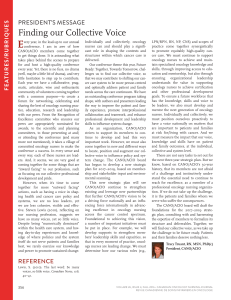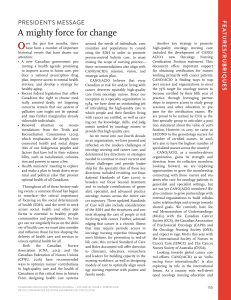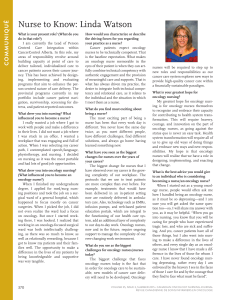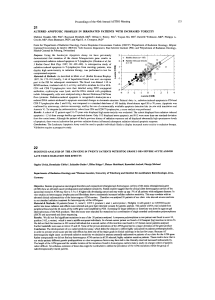Download this PDF file
publicité
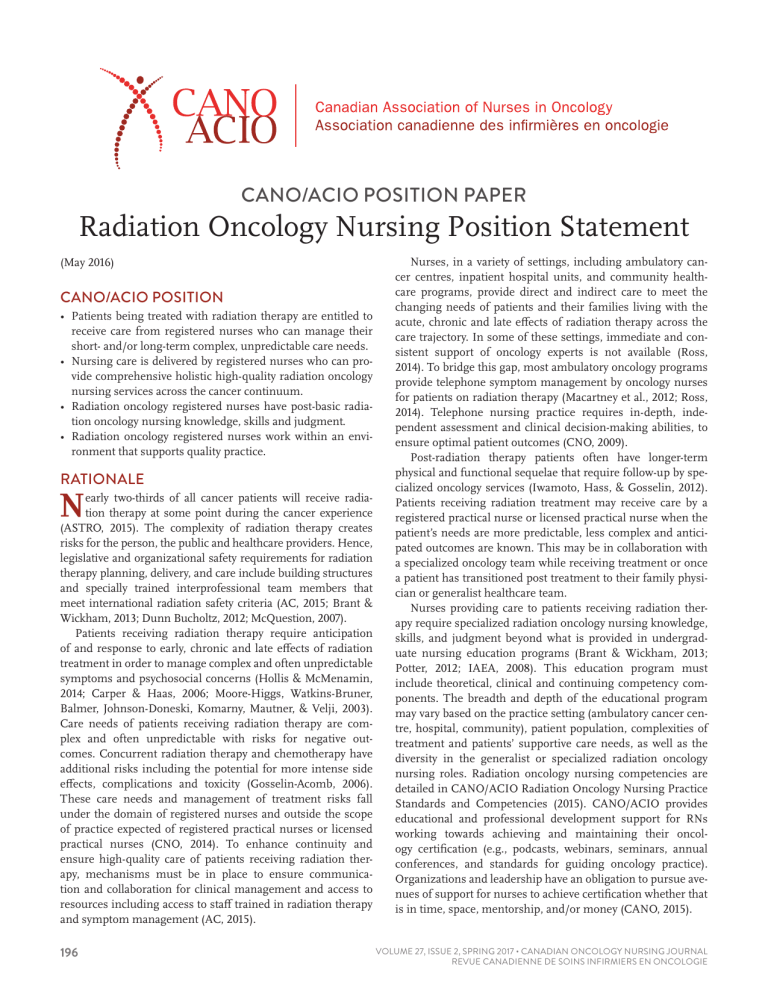
CANO/ACIO POSITION PAPER Radiation Oncology Nursing Position Statement (May 2016) CANO/ACIO POSITION • Patients being treated with radiation therapy are entitled to receive care from registered nurses who can manage their short- and/or long-term complex, unpredictable care needs. • Nursing care is delivered by registered nurses who can provide comprehensive holistic high-quality radiation oncology nursing services across the cancer continuum. • Radiation oncology registered nurses have post-basic radiation oncology nursing knowledge, skills and judgment. • Radiation oncology registered nurses work within an environment that supports quality practice. RATIONALE N early two-thirds of all cancer patients will receive radiation therapy at some point during the cancer experience (ASTRO, 2015). The complexity of radiation therapy creates risks for the person, the public and healthcare providers. Hence, legislative and organizational safety requirements for radiation therapy planning, delivery, and care include building structures and specially trained interprofessional team members that meet international radiation safety criteria (AC, 2015; Brant & Wickham, 2013; Dunn Bucholtz, 2012; McQuestion, 2007). Patients receiving radiation therapy require anticipation of and response to early, chronic and late effects of radiation treatment in order to manage complex and often unpredictable symptoms and psychosocial concerns (Hollis & McMenamin, 2014; Carper & Haas, 2006; Moore-Higgs, Watkins-Bruner, Balmer, Johnson-Doneski, Komarny, Mautner, & Velji, 2003). Care needs of patients receiving radiation therapy are complex and often unpredictable with risks for negative outcomes. Concurrent radiation therapy and chemotherapy have additional risks including the potential for more intense side effects, complications and toxicity (Gosselin-Acomb, 2006). These care needs and management of treatment risks fall under the domain of registered nurses and outside the scope of practice expected of registered practical nurses or licensed practical nurses (CNO, 2014). To enhance continuity and ensure high-quality care of patients receiving radiation therapy, mechanisms must be in place to ensure communication and collaboration for clinical management and access to resources including access to staff trained in radiation therapy and symptom management (AC, 2015). 196 Nurses, in a variety of settings, including ambulatory cancer centres, inpatient hospital units, and community healthcare programs, provide direct and indirect care to meet the changing needs of patients and their families living with the acute, chronic and late effects of radiation therapy across the care trajectory. In some of these settings, immediate and consistent support of oncology experts is not available (Ross, 2014). To bridge this gap, most ambulatory oncology programs provide telephone symptom management by oncology nurses for patients on radiation therapy (Macartney et al., 2012; Ross, 2014). Telephone nursing practice requires in-depth, independent assessment and clinical decision-making abilities, to ensure optimal patient outcomes (CNO, 2009). Post-radiation therapy patients often have longer-term physical and functional sequelae that require follow-up by specialized oncology services (Iwamoto, Hass, & Gosselin, 2012). Patients receiving radiation treatment may receive care by a registered practical nurse or licensed practical nurse when the patient’s needs are more predictable, less complex and anticipated outcomes are known. This may be in collaboration with a specialized oncology team while receiving treatment or once a patient has transitioned post treatment to their family physician or generalist healthcare team. Nurses providing care to patients receiving radiation therapy require specialized radiation oncology nursing knowledge, skills, and judgment beyond what is provided in undergraduate nursing education programs (Brant & Wickham, 2013; Potter, 2012; IAEA, 2008). This education program must include theoretical, clinical and continuing competency components. The breadth and depth of the educational program may vary based on the practice setting (ambulatory cancer centre, hospital, community), patient population, complexities of treatment and patients’ supportive care needs, as well as the diversity in the generalist or specialized radiation oncology nursing roles. Radiation oncology nursing competencies are detailed in CANO/ACIO Radiation Oncology Nursing Practice Standards and Competencies (2015). CANO/ACIO provides educational and professional development support for RNs working towards achieving and maintaining their oncology certification (e.g., podcasts, webinars, seminars, annual conferences, and standards for guiding oncology practice). Organizations and leadership have an obligation to pursue avenues of support for nurses to achieve certification whether that is in time, space, mentorship, and/or money (CANO, 2015). Volume 27, Issue 2, Spring 2017 • Canadian Oncology Nursing Journal Revue canadienne de soins infirmiers en oncologie Authorship on Behalf of CANO/ACIO Members of CANO/ACIO Radiation Therapy Special Interest Group Christine Zywine, RN(EC), BScN, MSN, CON(C) Maurene McQuestion, RN, BA, BScN, MSc, CON(C) Tracy Truant, RN, PhD(c) REFERENCES Accreditation Canada (2015). Cancer Care Standards. In Cancer Care and Oncology Services. https://accreditation.ca/cancer-care Brant, J. & Wickham, R. (Eds.). (2013). Statement on the scope and standards of oncology nursing practice: Generalist and Advanced Practice. Pittsburgh, PA: Oncology Nursing Society. CANO/ACIO (2015). CANO/ACIO Radiation Oncology Nursing Practice Standards and Competencies. Vancouver, BC: Author. CANO/ACIO (2015). CANO/ACIO Oncology Nursing Certification Position Statement. Vancouver, BC: Author. CANO/ACIO (2006; July, 2009). Practice Standards and Competencies for the Specialized Oncology Nurse. Vancouver, BC: Author. Canadian Association of Radiation Oncologists (CARO) Manpower and Standards of Care Committee (2004). Radiation Oncology Scope of Practice in Canada. Markham, ON: Author. Carper, E., & Haas, M. (2006). Advanced practice nursing in radiation oncology. Seminars in Oncology Nursing, 22(4), 203–211. College of Nurses of Ontario (CNO) (2014). RN and RPN practice: The client, the nurse and the environment. Retrieved from http://www. cno.org/Global/docs/prac/41062.pdf CNO (2009). Telepractice. In Practice Guidelines. Retrieved from https://www.cno.org/globalassets/docs/prac/41041_telephone.pdf Dunn Bucholtz, J. (2012). Radiation protection and safety. In Iwamoto, R.R., Haas, M.L., Gosselin, T.K. (Eds.), Manual for Radiation Oncology Nursing Practice and Education (pp. 29–43). Pittsburgh, PA: Oncology Nursing Society. Gosseline-Acomb, T. (2006). Role of the radiation oncology nurse(PMID:17095395). Seminars in oncology nursing, 22(4), 198–202. Hollis, G., & McMenamin, E. (2014). Integrating nurse practitioners into radiation oncology: One institution’s experience. Journal of Advanced Practice in Oncology, 5(1), 42–46. Published online Jan 1, 2014. International Atomic Energy Agency (IAEA) (2008). A syllabus for the education and training of radiation oncology nurses. IAEA, Vienna. Retrieved from http://www-pub.iaea.org/MTCD/publications/ PDF/TCS-28_web.pdf Iwamoto, R.R., Hass, M.L., & Gosselin, T. (Eds.) (2012). Manual for radiation oncology nursing practice and education (4th ed.). Pittsburgh, PA: Oncology Nursing Society (ONS). Canadian Oncology Nursing Journal • Volume 27, Issue 2, Spring 2017 Revue canadienne de soins infirmiers en oncologie Allyson Nowell, RN, MSc, CON(C) Brenda Ross, RN, BScN, Special Project Lead, CANO/ACIO Approval by CANO/ACIO Board Original approval date: May 25, 2016 Macartney, G., Stacey, D., Carley, M., & Harrison, M. (2012). Priorities, barriers and facilitators for remote support of cancer symptoms: A survey of Canadian Oncology Nurses. Canadian Oncology Nursing Journal, 22(4), 235–240. McQuestion, M. (2007). Radiation protection and safety. In Hass, M., Hogle, W., Moore-Higgs, G.J., Gosselin-Acomb, T.K. (Eds.), Radiation therapy: A guide to patient care (pp. 25–35). Pittsburgh, PA: Oncology Nursing Society. Moore-Higgs, G.J., Watkins-Bruner, D., Balmer, L, Johnson-Doneski, J., Komarny, P., Mautner, B., & Velji, K. (2003). The role of licensed nursing personnel in radiation oncology. Part A: results of a descriptive study (PMID:12515984). Oncology Nursing Forum, 30(1), 51–58. Moore-Higgs, G.J., Watkins-Bruner, D., Balmer, L., Johnson-Doneski, J., Komarny, P., Mautner, B., & Velji, K. (2003). The role of licensed nursing personnel in radiation oncology. Part B: Integrating the ambulatory care nursing conceptual framework. (PMID:12515984). Oncology Nursing Forum, 30(1), 59–64. ONS (1992; revised July 1997, June 1999, November 2002, July 2005, October 2007, January 2011. Reviewed October 2012, January 2013, January 2014, January 2015). Position Statement: Education of the RN who administers and cares for the individual receiving chemotherapy and biotherapy. Retrieved from https://www.ons.org/ advocacy-policy/positions/education/chemotherapy-biotherapy ONS (2006). Position Statement: Oncology services in the ambulatory practice setting. Oncology Nursing Forum, 33(4), 687–688. Perez, C.A., & Brady, L.W. (2013). Preface, 1st edition. In Halperin, E.C., Wazer, D.E., Perez, C.A., & Brady, L.W. (Eds.), Perez and Brady’s Principles and Practice of Radiation Oncology. Potter, R., Eriksen, J.G., Beavis, A.W., Coffey, M., Verfaillie, C., Leer, J.W., et al. (2012). Competencies in radiation oncology: A new approach for education and training of professionals for radiotherapy and oncology in Europe. Radiotherapy and Oncology, 103, 1–4. Ross, B. (2014). Review of evidence to inform the development of CANO/ ACIO radiation oncology nursing practice standards and competencies. Vancouver, BC: Author. 197

